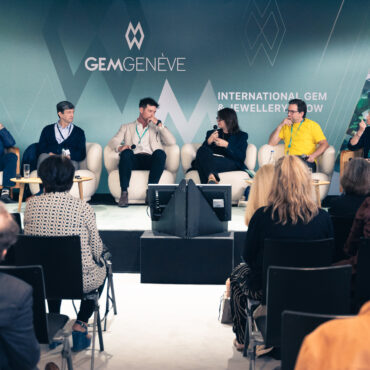The Rosalinde and Arthur Gilbert collection is one of the world’s most comprehensive collections of micro-mosaics. Arthur Gilbert coined the term ‘micro-mosaic’ himself and supported the pioneering publications and exhibitions on the subject. During this lecture, Alice Minter, Curator of the Rosalinde & Arthur Gilbert, will present renowned highlights from the collection and the latest information uncovered for these finest pieces.
Speakers: Alice Minter, Senior Curator, The Arthur and Rosalinde Gilbert Collection
Without the Gilbert collection, there will be no micro-mosaic. The Gilbert collection is one of the finest and most comprehensive collections of micromosaics in the world, and indeed Arthur Gilbert coined the term ‘micro-mosaic’ himself. Mosaic in miniature existed since ancient times, but the Roman technique that flourished in the 18th century used to be called “mosaici minuti”.
Arthur Gilbert knew something was different; it was not simply about small miniatures. This is why he coined the word ‘micro-mosaic’ – this word describes real art and a revival of the art market, which has been happening over the last few decades from the 20th century.
Arthur Gilbert & the making of a collection
In London, Rosalind and Arthur Gilbert were both born in 1913 to Jewish families. Just before WWII, they started with a successful business of ready-to-wear, which continued until
1948.
In their early 30s, in 1948, they decided they had made enough money and moved and settled in Los Angeles. In the post-war era, everything was there to be created, and the Gilberts had plenty of possibilities, thanks to their fortune, to live the American dream to the fullest.
Arthur Gilbert started to invest in real estate, partnering with Hollywood actors, and in the early 1960s, he commissioned a villa on top of the hills of Beverly Hills. He wanted to furbish this new villa, so they started looking through auction houses and art dealers for pieces of furniture. This is when he found two crack paintings.
He bought these two cracked paintings, but after close analysis, he understood there was more to them – they were not cracked oils on canvas.
Instead, they were made of tiny, minute pieces of coloured glass of different shapes, rendering colours and shades in such a fascinating way that Arthur Gilbert started asking art
dealers and auction houses, and everybody was saying that it was another form of Roman mosaic.
But Arthur was not satisfied, and he also discovered that so many similar objects existed: large panels, tables, and jewellery – Arthur Gilbert started browsing and purchasing everything he could find on the art market.
By the mid-1970s, Arthur Gilbert came to be known as “the maniac that collects micromosaic” – his way of collecting was also maniacal because he wanted to build a comprehensive collection for everyone to enjoy.
People started to acknowledge him and his collection. Christie’s, Sotheby’s and other art dealers were coming to see his collection. However, he remained convinced that his collection had to be dedicated to the public.
In 1975 the Victoria & Albert Museum hosted the first exhibition featuring highlights from the Gilbert collection. A pioneering publication on the subject accompanied the show. Once
finished, the exhibition moved to Los Angeles, and from there, it then built a partnership with the Los Angeles County Museum so that almost the entirety of the Gilbert collection
(which also includes gold and silver boxes and portrait enamels) stayed for 20 years at the Los Angeles County Museum.
In 1995 Arthur Gilbert decided to withdraw the entire collection and give it back to the UK because this is where he was from.
The collection found a new home at Somerset House for eight years, with seventeen galleries. Since 2008 it has been on permanent loan at the Victorian & Albert Museum, with four galleries dedicated to presenting most objects.
Therefore, Arthur Gilbert and his collection are of enormous importance because, without his insisting on having a name attached to that precise technique, without him buying absolutely everything that he could find on the art market, and without him supporting a pioneering exhibition and publication, the knowledge about micro-mosaic would have gone.
The Micro-mosaics
Objects in the micro-mosaic technique can range from a panel two meters wide to fabulous tables, gold boxes and jewellery; from gold boxes to every single form of the micro-mosaic one could find: he bought them all. Arthur Gilbert also enjoyed buying the same subject in different formats.
The Colosseum is one of them, and in the collection, there is the same scene in different
formats: from a 5-centimetre brooch to a 120-centimetre panel. This allows comparing various artists to know more but also compare the quality, understanding the evolution of the craft and the technique of the micro-mosaic.
The tesserae forming micro-mosaics at the beginning came square. The micro-mosaic ‘sfilati’ technique consists of melting the coloured glass elements to create, at first, a huge block which is just then pulled into a cane the diameter of a hair. The result depends on the work of the wrist and its speed.
This also influences the colours, which are never the same because one extra second of work will create a different shade. The tesserae resulting from this manual work measure half a millimetre and are one to two millimetre high.
Despite witnessing the technique, so many questions remain unanswered as they are artisanal secrets: about polishing, about the type of mastic used. The micro-mosaic is art; nothing is written on the subject, and the only way to understand this art is by going through the masterpieces themselves. Some creations have more than 5,000 tesserae per square inch (5 centimetres by five centimetres). While collecting, Gilbert carefully and purposefully chose every item that would reflect that technique’s history and the art’s evolution.
Micro-mosaics: a chronological history
Initially, it was not about micro-mosaic but mosaic in miniature. One object dating 1566 clearly shows this aspect.
The tesserae are still square but tiny, and there is already a mastery in colour shades. For the time, it was a remarkable object, which won the first prize at a competition organized in
Venice.
The mosaic technique started in Rome and, from the 7th century, very quickly moved to Venice, where there are beautiful examples in Byzantine churches, like Ravenna. Finally, after two centuries of stopping, the mosaic returned with the works at the San Marc’s Basilica in Venice. In 1566 a competition was organized to declare the best mosaicist in Venice. The task was to render a painting (probably by Titian himself) with all its details into a refined mosaic.
The Duke of Savoy, fascinated by the result, asked Venice to send him some mosaicists to create their workshop. The Venice Authority refused, but they sent him the mosaic that won the competition. So that mosaic went into the collection of the Duke of Savoy, and somehow it was inherited by the Cardinal de Richelieu and stayed until the French Revolution in the collection of the Richelieu family. Unfortunately, the mosaic went lost after the French Revolution until one day, Arthur Gilbert acquired it in 1976.
When discussing the technique, it is essential to remember that it all started in the 13th-14th century in Venice, where there was a workshop to build all the mosaic decorations of Saint
Marc’s Basilica. Then, in the 16th century, the Pope decided they would do the same with Saint Peter’s Basilica in Rome, so he invited some Venetian artists to set up their mosaics workshop. This is how it started: first to decorate San Peter’s Basilica with some mosaics, and then to begin replacing the paintings which were fading with mosaics. This continued from the late 16th century to the mid-18th century. In the meantime, they constantly tried to improve their art and technique, so the late 1770s was an important date for micro-mosaic because the method was fully developed.
One prominent name in the history of the micro-mosaic is the name of Giacomo Raffaelli. Giacomo Raffaelli is considered the inventor of the micro-mosaic technique. He was also the first to organize private sales of micro-mosaics to a private clientele of non-religious subjects. His key themes were birds and little butterflies in small pieces – some measuring six centimetres, which is quite remarkable.
Raffaelli’s name became a sort of ‘brand’ for micro-mosaic in Rome and beyond because his reputation reached even the Russian court. So, not only clients belonging to the aristocratic and bourgeois classes, but even Napoleon and the Russian Tzars knew about him. Raffaelli started a fashion that would last for a hundred years and fade immediately after.
He not only used square tesserae, but also tesserae of different forms, and in addition, he started working with hard stones, such as agate, jade, amethyst and some marbles.
He was so advanced in the technique that he created vases which, still today, do not reveal how Raffaelli managed to have the mosaic tesserae curve follow the structure of the vase itself – knowing that the mosaic is on a flat surface, this technical achievement remains a mystery.
These vases might have been a creation for Napoleon – a gift of the Pope to the newly crowned Emperor.
Another essential creation by Raffaelli today in the Gilbert collection is a clock – one of four, dating 1804, clock movement by Abraham-Louis Breguet – thought to be a gift from Eugene
de Beauharnais to his mother, Josephine. The clock follows the neoclassic style; it looks like a Greek temple, with front amethyst columns and micro-mosaic panels between the columns.
This clock disappeared. Vincenzo, Giacomo Raffaelli’s nephew, went to Saint Petersburg in the early 1850s but could not find it. Eventually, despite the blank on the clock’s whereabouts – which might have ended up at the Swedish Court – Gilbert managed to acquire it in 1979.
Following Raffaelli’s commercial success, more micro-mosaicists followed his example and started producing luxury souvenirs.
At that time, journeys around Europe would take a long time to complete; in the 19th century, the Grand Tour was fashionable among young aristocrats to polish their education, and these travellers wanted tokens to bring back home, to show the places they had visited – especially in Italy and Rome. The so-called “souvenir jewels” became fashionable: in gold and micro-mosaics, there were portable views of the places these ladies and gentlemen had visited in the fashion that was in style at the time.
Another luxury souvenir was the snuffbox. The Gilbert Collection has a few snuffboxes, which were used from the 18th century onwards and would be carried around – just like the fans for ladies. So, the practice would be to purchase a micro-mosaic panel with a specific scene and mount it once back home in gold or silver boxes.
These luxury souvenirs, produced in large quantities, are handy to keep deepening the knowledge of micro-mosaic art. As stated earlier, it was an art not only for affluent travellers but also for Kings and Emperors, who commissioned large panels and tables for their residences.
Another prominent micro-mosaic artist Michelangelo Barberi developed his art in the second half of the 19th century.
Giacomo Raffaelli started in 1775, followed by his son and his nephew, so the business continued up to the 1830s. He also trained a new generation of mosaicists in the second half of the 18th century. The first portrait we know by Michelangelo Barberi was from the late 1820s because it was for the future Tzar Nicolas I.
Barbieri also produced tables that can be dated to the late 1860s: one was called “The Beautiful Sky of Italy”; the original one was commissioned by Tsar Nicholas I to Michelangelo Barberi directly, and it is at the Hermitage Museum. The second table was for an English aristocrat and was presented at the Great Exhibition in 1851. Arthur Gilbert acquired this second table. Another table was called “Flora of Two Sicilies”, belonged to and was commissioned directly by Tzar Nicolas I after 1844 – he did a tour of Italy. In the table, he chose to illustrate the different sites he had visited with their names and little personal details, like the profile of one of his daughters. While Barberi was working for the Russian Court, Russian artists were going to Italy to be trained, and the Tsar managed to have Italian artists come and open their workshop in Saint Petersburg – one of these being Domenico Moglia. Moglia discovered a local talent who, at the time, was painting Easter eggs. His name was George Ferdinand Wekler. Wekler, trained by Moglia, started producing his micromosaics and soon became a Tsar’s favourite, who was very proud of having a Russian artist mastering the art of micro-mosaics.
These objects are precious because they also amplify the span of the collection: the focus is not only or simply on the Roman mosaic art but on all the subsequent developments through time and space.
By the 1880s, the market started to flatten and lose interest. There were different reasons, one probably being a lack of creativity, which didn’t evolve with time. As a result, subjects
that were once very popular at the beginning of the 20th century (dominated by the Art Nouveau and the Art Deco movements) went entirely out of fashion.
Another possible reason for the falling out of the grace of micro-mosaics could be the enormous amount of time needed to create a panel. With the beginning of the 20th century, fashion, art, and the very same notions of time and space changed. Times were perceived differently, and an idea developed to be quicker, to go faster. And micro-mosaics were not in the scope.
Last but not least, photography developed supplanting luxury souvenirs with ultra-realistic vistas in the micro-mosaic that were so fashionable to bring back home from long European tours. In addition, photography became more portable and cheaper, which might have been another cause of the death of the art of micro-mosaic.
Micromosaic: art or craft?
Ten years after Giacomo Raffaelli started his activity, Goethe went to Italy from 1786 to 1788 and published his work, Italian Journey, in 1816-17. While walking through, he wrote: “our
times are worse than we think the art of Mosaic which once gave the ancient their paved flaws and the Christian the vaulted Heaven of their churches has now been degraded to Snuff boxes and bracelets”.
Indeed, the objects produced in the 1810s-1820s do not have the same quality. A lot of these objects are mere copies. There is nothing as for the art of reinterpreting a painting, for
example, that there used to be. The effort of making the art perfect has disappeared, as well as the study of the tesserae, in different shapes and forms, to render shades and volumes to perfection, to the point that they resemble a brush stroke.
In its glory days, the micro-mosaic had become an entire philosophical art. Michelangelo Barberi said: “This art form at first appears so easy if undertaken commercially but it proves
to be difficult, indeed extremely so, if one aims to practice it as an artist and a philosopher. I want to urge you, to not limit yourself to the purely mechanical aspect of mosaic-making,
but to also learn about drawing, the brush and the humanities. If you do so, it will be a great service indeed to yourself and to Rome with its already significant trade in mosaics.”
Objects in micro-mosaics became a testament to the highest in execution and carried deep meanings. By looking at them, one could ask oneself: do I see a mosaic or a painting? Do I see art or a craft? Does this object have a philosophical meaning, or is it simply decorative? All these readings are possible, and thanks to the richness and variety of the Arthur Gilbert collection, today we can try and find all the answers to questions about a savoir-faire that is coming back and being appreciated by the public worldwide.





